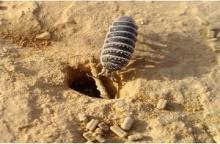- About us
- Research
- Students & Teaching
- Seminars & Events
- Directories
- Booking Rooms & Equipment
- עברית
Home » Prof. Hawlena and Mr. Sagi present - the desert isopod : the cleanliness trustee of the Negev
Nutrient cycling in most terrestrial ecosystems is controlled by moisture-dependent microbial activity. In arid ecosystems, plant litter cycling exceeds rates predicted based on precipitation amounts, suggesting that additional factors are involved. Previous attempts to reveal these factors have focused on abiotic degradation, soil–litter mixing and alternative moisture sources. Our aim was to explore an additional hypothesis that macro-detritivores (large invertebrates that feed on plant litter) control litter cycling in deserts, focusing on a highly abundant macro-detritivore, the desert isopod Hemilepistus reaumuri,
We quantified the role different organisms play in clearing plant detritus from the desert surface, using litter baskets with different mesh sizes that allow selective entry of micro-, meso- or macrofauna. Macro-detritivores controlled the clearing of plant litter in our field site, accounting for almost 90% of the annual litter removal. The highest rates of litter removal were measured during the hot and dry summer when isopod activity peaks and microbial activity is minimal.
To examine whether litter clearance by isopods results in accelerated mineralization, we measured soil nutrient concentrations in increasing distances from their burrows, and found substantial enrichment of inorganic nitrogen and phosphorous near the burrows.
In a complementary lab microcosm experiment we observed isopods within their burrows and recorded the frequency of occurrence of isopods and isopod feces in different depths along the soil profile. We also measured soil nitrogen concentration and found that it accumulates at intermediate soil depths, which corresponds to isopod tendency to occupy this zone within the burrow. This is most probably a result of isopods excreting gaseous ammonia that is being adsorbed to the moist burrow walls.
We conclude that burrowing macro-detritivores are important regulators of litter cycling in this arid ecosystem, providing a plausible general mechanism that explains the unexpectedly high rates of plant litter cycling in deserts. Isopods account for a great fraction of litter removal from the desert surface, and their burrows serve as conduits of nitrogen and phosphorus into the soil that may become islands of fertility in an otherwise poor environment.
